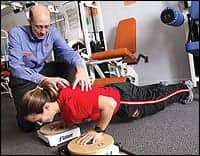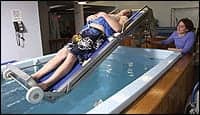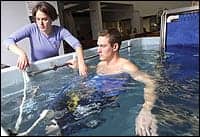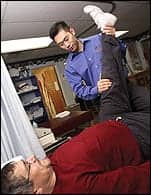 |
| Robert W. Babb, PT, MBA (left), Physical Therapy & Wellness Institute owner, oversees client Ann Marie Browne’s athletic conditioning. |
Before opening the Physical Therapy & Wellness Institute (PTW) in the Philadelphia suburb of Lansdale, Pa, Robert W. Babb, PT, MBA, was part of a team of PTs that provided aquatic therapy for the Philadelphia Eagles. But when he left his old firm to open PTW, Babb knew he would not be seeing 300-pound pro linebackers recovering from severe bone fractures and torn ligaments anymore, yet he still expected to be seeing athletes.
“There is an athlete in all of us,” Babb says. “Whether it’s a soccer player, bowler, or someone who simply has gone out dancing with friends, we all have to have the physical abilities to do those things.”
It is this athlete-in-all-of-us philosophy that drives Babb to offer not only physical rehabilitation and aquatic therapies for those recovering from injuries, but also a variety of sports and conditioning programs for everyday athletes who want to be at their best.
Babb says, “When the body starts to show its wear and tear—whether [clients] are young or old—that’s when we run into problems and where [PTW] can help achieve their goals.”
BODIES UNDER REPAIR
 |
| With the help of a lift, Tracy Jo Binden, DPT (right), lowers Benjamin White into a therapy pool. |
PTW’s trademarked slogan is “Bodies Under Repair.” The slogan seems fitting given the number of bodies that Babb has personally helped repair over the years. He began his PT career in the US Navy, then eventually worked his way to becoming the COO and senior vice president of his former employer, a noted Philadelphia rehabilitation center. Despite the demands of operating PTW and its sister facility in nearby Quakertown, Babb continues to be an active physical therapist, businessman, and public speaker.
Asked about balancing his time as a hands-on therapist and manager, Babb credits his military background and his staff. He also feels that internal reports and dialogue within his organization are critical to being successful in both positions. He says, “Our communications are set up by weekly staff meetings. It sets me up for long weeks, but the meaningful relationships that are developed are worth every minute.”
In addition to PTW’s “Bodies Under Repair” theme, Babb always keeps in mind the company’s mission statement: “To give high-level, quality-driven therapy and quantifiable fitness products and services to our valuable customers while deriving a profit.” Babb easily repeats that statement with conviction and sincerity. “It’s a business,” he says, “and I expect us to be profitable, I expect us to be quantifiable, and I expect us to be empathetic and listen to our customers.”
REPAIRING A VARIETY OF CONDITIONS
The actual bodies that PTW repairs come from all age groups, but Babb estimates that 50% of his clients are high school students, 12% have work-related injuries, and 11% have injuries caused in motor vehicle accidents. The remaining clients are Medicare patients with age-related issues.
 |
| Tracy Jo Binden, DPT (left), prepares Benjamin White for an aquatic therapy session. |
While some rehabilitation centers may be slow between 3 pm and 5 pm, PTW has almost a full house due to its high number of high school athletes. Babb admits that aside from PTW’s great reputation, its location near two high schools is one reason why the center attracts so many young patients. “I get into having fun with [the students], because keeping it fun is, I think, what keeps them coming here too,” Babb says.
The predominant conditions that PTW sees for physical therapy are knee injuries, comprising 50% of its cases. In fact, Babb sees so many anterior cruciate ligament (ACL) patients that he often recognizes a former client in the local store by the type of knee injury before remembering their name.
Babb says, “Postoperatively, an ACL is a unique rehabilitation because it’s lengthy and there’s psychology involved. There’s a lot of education and getting [clients] to understand that this is not so much a disability, but how we can enable them during their recovery process. For example, how we can get them on a bike for their opposite leg, or get them to do some straight leg raises at home.” Babb and his PTW therapists also teach ACL patients various kinds of transfers in order to help them feel more independent and to increase their sense of self-worth.
 |
| PTW clinical supervisor Andrew Seo, DPT, (right) works with patient Ronald L. Klein. |
As an example of the extra education and motivation required for his younger patients, Babb cites a 17-year-old ACL client who had come to PTW 10 days after surgery for his first postoperative session. “I said, ‘I need you to do 10,000 quad sets a day.’ And he said, ‘Are you kidding me?'” Babb then patiently explained how research indicates that the average person contracts the muscles in their legs 10,000 to 12,000 times per day. He went on to ask the young man to spend every waking hour trying to contract the muscles with his knee straight whenever he could, and that doing so would help reduce muscle atrophy.
PTW also looks forward to what Babb jokingly calls “shoulder season.” Shoulder season starts after the summer when PTW sees the most rotator cuff and shoulder injuries due to the great American pastime, Little League baseball. Babb says, “Soccer and baseball seem to be the passions of this Lansdale-Montgomeryville area. Boys and girls are playing in two or three baseball leagues, and their arms break down.”
Consequently, PTW therapists spend a great deal of time educating children—and their parents—about how to offset damaging the young athlete’s throwing arm through hard-thrown pitches and repetitive motion.
Although it is difficult for some kids and their parents to hear, Babb recommends avoiding throwing any curveballs before the age of 15. Many parents sign their kids up for PTW’s self-pay sports performance programs, preparing players for March 15—when spring training begins.
SELF-PAY ANCILLARY PROGRAMS
Aside from offering physical and aquatic therapy that is generally insurance-paid, PTW has three self-pay programs for its community of athletes. Each program derives ancillary revenues above and beyond PTW core PT practice, while also creating good relationships for possible insurance-paid physical therapy. The programs include: a prep program for surgery; a medically based exercise program; and a sports performance program.
The prep program is designed for patients wanting to prepare and condition the body for surgery, typically for an upcoming knee replacement or ACL reconstruction. For $60 a month, a PTW therapist designs an appropriate exercise program. The price includes access to all of PTW’s equipment as well as the ability to ask a PT for answers to further questions. Besides being affordable, Babb also believes the program establishes a relationship with clients who usually choose to return to PTW for any needed rehabilitation after surgery.
PTW’s “medically based exercise program” was formerly called a fitness program, but a “fitness program” could mean anything, from Pilates to spinning, to free weights. Babb explains, “Fitness was such a generic by-product of years gone by, and we said to ourselves, ‘Can we define ourselves better?’ In the end, we decided to call it medically based exercise because that’s our target audience. We have only 5,000 square feet here. If I open up the doors and say, ‘We’re a fitness center,’ we’re going to get healthy people coming in that want to lift weights and grunt. If we call it a medically based exercise program, we’re going to get folks who may have an acknowledgement from the local physician group that this is an exercise program for individuals who may or may not have joint pain, and want or require a little more supervision.”
The medically based exercise program consists of supervision by one of PTW’s exercise physiologists, monthly body fat testing, weigh-ins, a sit-reach test, and a heart rate test that measures both a target rate and an exercise rate. Babb says, “We try to get them as close to 60% to 70% of their maximum heart rate, depending on if they’ve had medical problems.” As with the surgery prep program, PTW charges a nominal $60 per month, which includes access to all facilities and a PT, if needed. After the first month, the client can pay an additional $150 permanent membership fee and receive a reduced rate of $45 per month.
PTW’s third self-pay ancillary product is the sports performance program, which targets young athletes (and their parents) who want to prepare or maintain their conditioning for a particular goal or sport, such as baseball. Babb designed the product as an 8- or 12-week package that incorporates training one-on-one with an exercise physiologist and performance tests. After the athletes discuss their goals with an exercise physiologist, PTW benchmarks them using the Illinois agility test, a vertical jump-test, a sit-reach flexibility test, a body fat test, and a resting heart rate.
Then the training begins to meet the person’s stated goals. Additionally, the athlete is retested each month, and the results are compared to those of previous tests for improvements.
Babb says, “We put the program in 3 years ago, and it’s done a couple of things. One, it’s given us a little more presence in the community and something to go out and talk in the community about. Second, it’s given us an opportunity to work with these young athletes where we may not have worked with them before. Also, God forbid, if they got injured in the future, they know where to go.” During the summer months, PTW sees around 25 athletes per week.
MARKETING: FOSTERING RELATIONSHIPS
If one could sum up the strategy for all that PTW does for marketing—and it does a lot—it would come down to developing key relationships. Those relationships not only include the clients in front of them, but also individual physicians, physician groups, their front desk people, insurance people, parents, and the high school community.
“We try to keep it simple,” Babb says. “Fostering relationships in the community is key, with our referral sources, with our customers, and with our business partners. I think I see physicians 3 to 4 days a week along with the other therapists. So we’re always going out and trying to see physicians.”
When asked what he tells the physicians when he meets with them, Babb responds, “We’re not telling them anything. We’re asking them, ‘How are we doing?’ We’re asking them to fill out some satisfaction surveys, and we’re asking them, ‘Is there anything else we can do for their patients?’ We’re trying to find out what their needs are and if there are any other opportunities to see more of their patients.”
Before sitting down with a physician, Babb looks at the types of referrals he has received from the person over the past 3 months. If he notices that all of the referrals were knee patients and the physician’s specialty is back surgeries, Babb is not afraid to ask the physician about his opinion of PTW’s back rehabilitation program. Babb says, “I’m always trying to draw them out and getting an understanding of what their perception is of our practice, our facilities, our people, and everything that comes with it.”
PTW also builds physician relationships by hand delivering each initial evaluation to the referring physician’s office, thereby building a rapport with the front desk people.
Tuesday staff meetings discuss any PT issues, then break down the number of referrals, who referred, for what diagnoses, and which physicians should be personally seen next.
Aside from face-to-face marketing, Babb spends about 4% of PTW’s budget on advertising in the local newspapers, yellow pages, and publications from local school sports teams and booster clubs. PTW also sponsors radio broadcasts of high school basketball games by providing a half-time radio show about conditioning and sports injuries. For the sponsorship of football game broadcasts, PTW picks the play of the day.
Babb also uses a public relations specialist to help write press releases, publicize PTW and its special events and promotions, as well as design and distribute PTW brochures throughout the local community.
SHARING KNOWLEDGE
PTW has eight physical therapists, two physical therapist assistants, and four exercise physiologists on staff, plus five clerical positions. Along with marketing and analyzing their referral base, Babb is always encouraging his entire staff to break down communication barriers and interact with customers and physicians.
He says, “Therapists that come in have to understand that they are the CEO of the clinic when they’re here. So they have to get on the phone with the doctors often and communicate with the doctors. I have to get them comfortable with that. The second tier staff, the support staff, has to understand that they’re just as important in this process as the rest of us.”
Babb also asks his exercise physiologists to generously share their knowledge with the self-pay clients. “Some of these out-of-pocket patients that come in, they expect their knowledge as exercise physiologists,” says Babb. “So, the exercise physiologists and the secondary staff really need to get with our self-paying people and give them their knowledge and give them a piece of their education every time that they’re in.”
ON THE ROAD TO RECOVERY
Walking through the front doors of PTW’s main 5,000-square-foot Lansdale location, clients first notice the two 8- x 10-foot aquatic therapy pools. The next thing they notice is PTW’s “Road to Recovery.”
The “road” is not actually on the ground, but painted on the facility’s walls, just below the ceiling. Visitors will immediately see the faces of almost 2,000 clients that PTW has repaired since 2002. “It’s a real neat thing to see,” Babb says. “There’s a big plaque on the wall that says, ‘This road to recovery is in honor of the folks who have chosen us as their physical therapy provider and are on the road to recovery.'” Babb enjoys watching people when they first walk into the facility. Usually, they are trying to find the faces of their friends and family, which gives the staff an opportunity to communicate with clients.
PTW’s Quakertown satellite location also has a “Road to Recovery,” but it is a smaller one with only 200 faces. Due to its smaller 1,000-square-foot size, the facility lacks therapy pools. He says, “Our hope is to add two pools there, similar to what we have here. But we have to tend to the needs of the [Lansdale] facility first.
As a result, PTW is putting its resources into adding a 1,500-square-foot building at the Lansdale location. The extra space will be used for expanding the medically based exercise program and for administrative offices.
Babb says, “We have administrators working right now in an 8- x 10-foot office with two desks in them. So, we’ve really tapped out all 5,000 square feet of this building.”
Babb expects the new addition to be completed by June, and then anticipates helping more bodies under repair and onto PTW’s “Road to Recovery.”
Tor Valenza is a staff writer for Rehab Management. He can be reached at .




